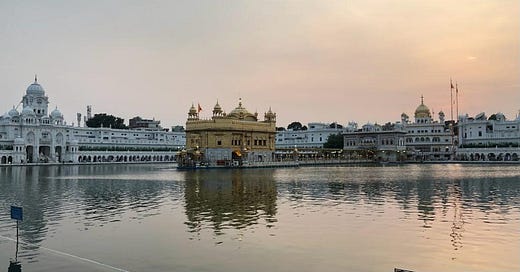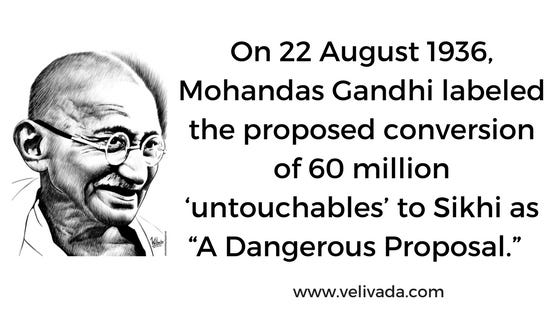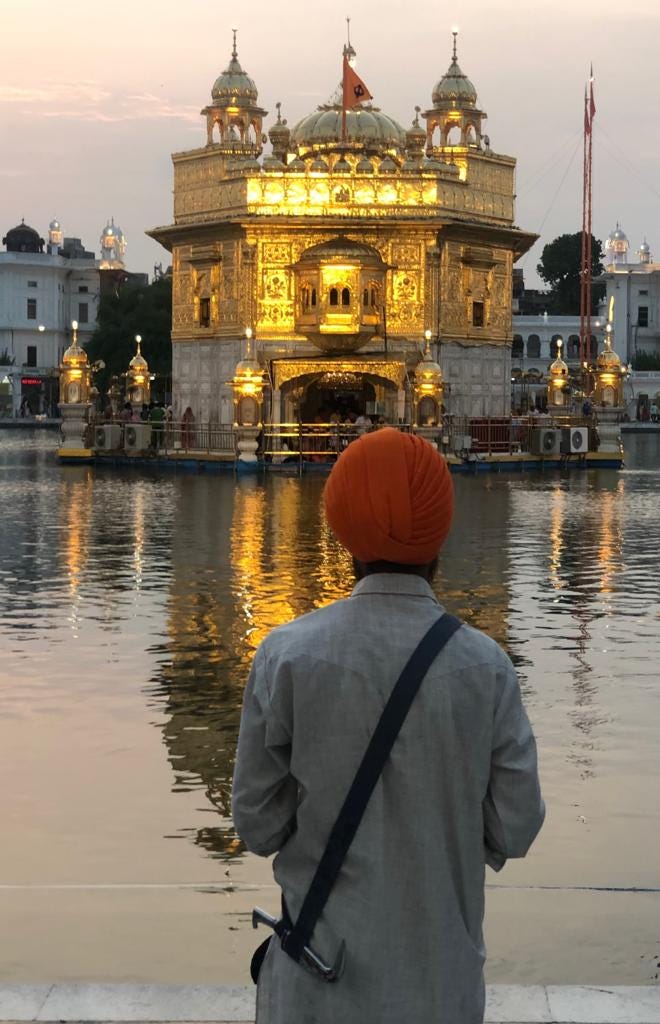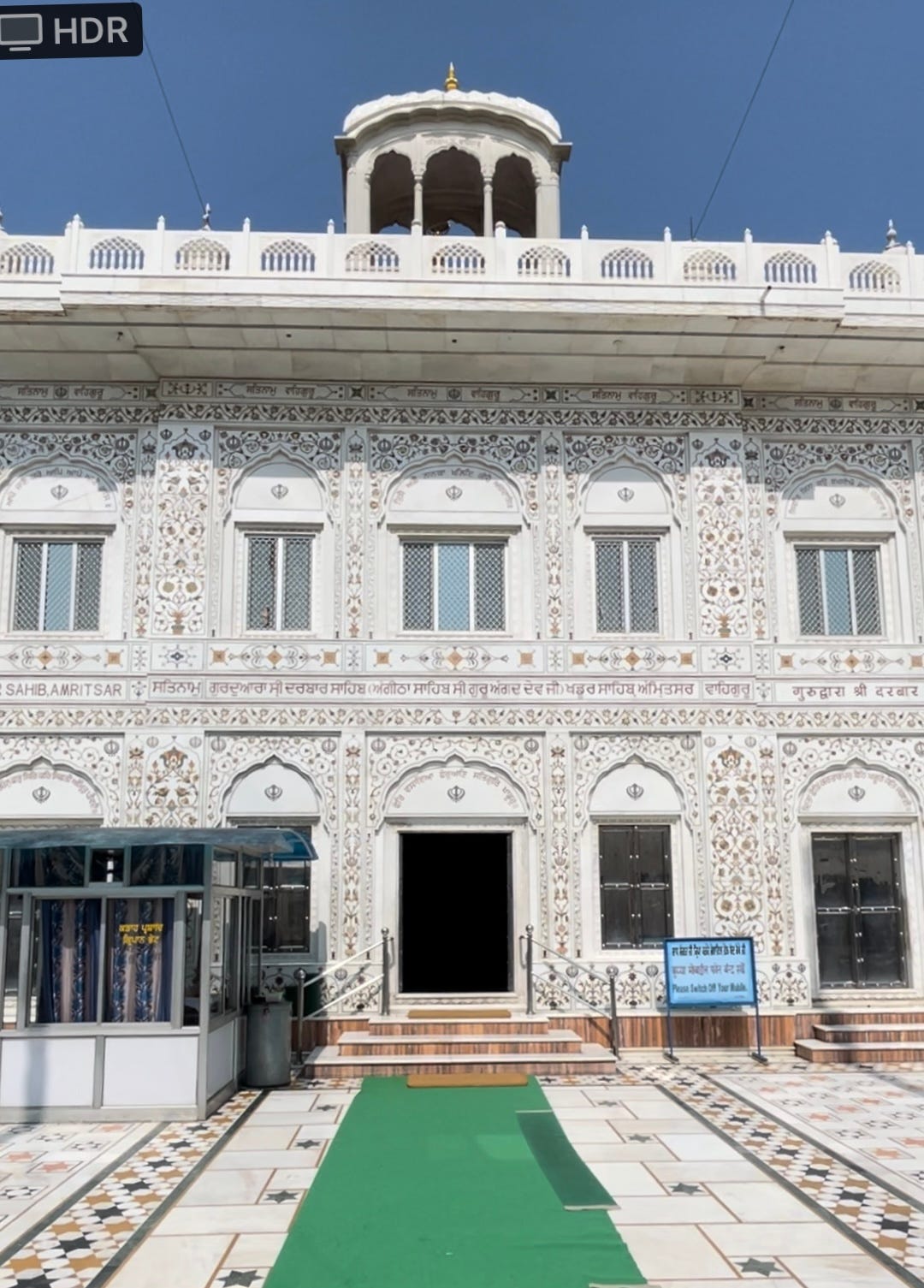Birth of Gurmukhi: How it Survived the Mughals, the Monarchy, and the Mahatma
Mahatma Gandhi's stance, in spite of his active support for the Gurdwara Reform Movement of the Akali Dal, on the Gurmukhi script was deeply controversial and at odds with Sikh cultural identity.
Birth of Gurmukhi: Introduction
The evolution of the Gurmukhi script is an indelible chapter in the story of Sikh resilience and Punjabi identity. Standardized by Sri Guru Angad Dev Ji, the second Sikh Guru at Khadoor Sahib, it was meticulously refined to record Gurbani (sacred Sikh hymns) and to assert Sikh distinctiveness amidst Brahminical and Persianate influences. Over the centuries, Gurmukhi withstood Mughal persecution, British suppression, and ideological biases, including Mahatma Gandhi’s lesser-known stance, which regarded Sikhs as a sect within Hindu society. Today, while Gurmukhi is the official script of Punjabi in Punjab and throughout India, its rightful recognition beyond the state remains a contentious issue.
Guru Angad Dev Ji and the Birth of Gurmukhi
A Script for a New Faith
Before Guru Angad Dev Ji (1539–1552), Punjabi was written in scripts like Landa, Takri, Brahmi and Sharada, each deficient in phonetic precision. Recognizing the need for a systematic script to record Guru Nanak Dev Ji’s divine revelations, Guru Angad Ji refined and standardized Gurmukhi, literally meaning “from the mouth of the Guru.”
Gurmukhi: A Phonetic Marvel
Standardized by Guru Angad Dev Ji around 1539, Gurmukhi is a precise and structured script tailored for the Punjabi language. Derived from Laṇḍā scripts, it belongs to the Northwestern Brahmic script family and consists of 35 consonants (Akhar) and 10 vowels (Sur). What makes Gurmukhi unique is its abugida system, where consonants inherently carry the vowel sound [ə], modified through diacritics. The script’s foundation rests on three vowel bases—Ura (ੳ), Aira (ਅ), and Iri (ੲ)—ensuring a complete phonetic representation. Guru Angad Dev Ji’s reforms eliminated redundant conjunct characters, established a one-letter-per-phoneme system, and made vowel symbols mandatory, revolutionizing Punjabi literacy and solidifying Gurmukhi as the sacred medium for Sikh scriptures and literary expression.
Defining Features of Gurmukhi
Phonetically Exact: Unlike Persian or Sanskrit scripts, Gurmukhi was designed for precision in pronunciation.
Accessibility for All: Unlike Sanskrit, which was monopolized by Brahmins, Gurmukhi democratized literacy.
Foundation of Sikh Education: Guru Angad Ji established schools at Khadoor Sahib, promoting mass education.
An Assertion of Sikh Autonomy: Gurmukhi distanced Sikh tradition from Persian and Sanskrit influences, embedding it within the broader Punjabi identity.
Gurmukhi’s Survival Under Mughal Rule
Mughal Persecution and Sikh Resistance
Despite the Mughals imposing Persian as the official language, the Sikh Gurus ensured that Gurbani was written and preserved exclusively in Gurmukhi.
Guru Arjan Dev Ji (1563–1606) compiled the Adi Granth (1604) in Gurmukhi, preventing distortion of Sikh teachings.
Under Aurangzeb’s Rule: Sikhs concealed manuscripts and relied on oral traditions to withstand oppression.
Banda Singh Bahadur (1670–1716) issued administrative orders in Gurmukhi, reinforcing its role in governance and military communication.

Colonial Suppression and Gurmukhi’s Marginalization
British Promotion of Urdu and English
Following the annexation of Punjab (1849), British rulers marginalized Gurmukhi, favoring Urdu and English:
Education Policy (1854): English became the primary medium, along side Urdu, sidelining Punjabi in schools.
Religious Divide: British census policies encouraged Punjabi Hindus to identify with Hindi, undermining Gurmukhi.
Singh Sabha Revival
Amidst growing concerns, the Singh Sabha Movement (1873) launched a campaign to revive Gurmukhi:
Printing Press Boom: The first Gurmukhi printing press facilitated mass dissemination of Sikh literature.
Educational Institutions: Khalsa College, Amritsar (1892) and others restored Gurmukhi instruction in academia.
First Punjabi Newspaper: Akhbaar Sri Darbar Sahib (1874) promoted Sikh and Punjabi consciousness.
Mahatma Gandhi’s Stance on Gurmukhi and Sikh Identity
Gandhi ji’s View of Sikhism as a Hindu Sect
Gandhi on Sikhism: “To me, Sikhism is a part of Hinduism.” This stance ignored Sikhism’s distinctiveness and was strongly opposed by Sikh leaders.
Opposition to Sikh Political Autonomy: He resisted separate Sikh electorates, advocating Hindu-Sikh unity at the cost of Sikh identity, just as he had opposed separate electorates for the Muslims and the Scheduled Castes.
Gandhi’s Support for the Akali Movement and Sikh Struggles
Mahatma Gandhi's support for the Gurdwara Reform Movement, also known as the Akali Movement, was significant and multifaceted. Following the tragic Nankana Sahib massacre on February 20, 1921, where peaceful Sikh reformers were brutally killed by Mahant Narain Das and his mercenaries, Gandhi visited the site on March 3, 1921, to express solidarity with the Sikhs. He condemned the violence, describing the martyrdom of the Akali reformers as an "act of national bravery" and urged the Sikhs to unite with the rest of India against British rule. Gandhi's involvement elevated the Akali cause to a national level, integrating it with the broader non-cooperation movement.
The Mahatma's admiration for the Akalis' non-violent approach was evident in his writings and speeches. He frequently cited the Akalis' peaceful resistance as an exemplar for other satyagrahis, particularly during the Guru-ka-Bagh Morcha. When Akali volunteers faced brutal police beatings while asserting their right to cut timber at Guru-ka-Bagh, Gandhi praised their unwavering commitment to non-violence. This peaceful suffering garnered widespread sympathy and support, including from Christian missionaries like C.F. Andrews. Gandhi’s endorsement of the Akali strategy culminated in his famous telegram to Baba Kharak Singh, President of the S.G.P.C., after the Keys Affair victory: "FIRST BATTLE FOR INDIA'S FREEDOM WON CONGRATULATIONS". His support not only strengthened the Akali movement but also aligned it closely with the national freedom struggle, making it a powerful force in pre-partition Punjab’s political landscape.
Dr Ambedkar’s Proposal for Mass Conversion to Sikhism
The proposed mass conversion of 60 million untouchables to Sikhism in 1936 marked a critical moment in Indian social history. Dr. B.R. Ambedkar, after his historic announcement in 1935 to leave Hinduism, saw Sikhism as an attractive alternative due to its egalitarian principles and Indian roots. He strategically reasoned that Sikhism would keep the converts within the Hindu broader cultural sphere while providing them dignity and equality, unlike conversion to Christianity or Islam, which he believed would “denationalize” them. His vision presented a radical shift in India’s caste dynamics, aiming to uplift millions from untouchability through an identity rooted in social equality and self-respect.
Gandhi’s Opposition and the Collapse of the Plan
However, Mahatma Gandhi's vehement opposition proved to be a crucial roadblock. On August 22, 1936, he labeled the proposed conversion as “A Dangerous Proposal” and controversially stated that “it would be far better if crores of untouchables converted to Islam than become Sikhs.” His intervention was not merely rhetorical—he breached confidentiality by publicly opposing the plan that had been shared with him privately, effectively undermining the initiative. Gandhi’s opposition stemmed from his view of Sikhism as part of Hinduism and his fear that such a mass conversion would fracture Hindu society. Meanwhile, the plan progressed initially, with Ambedkar sending thirteen followers to study Sikhism at the Amritsar Sikh Mission in 1936 and participating in Sikh conferences. However, the plan ultimately failed to materialise due to multiple factors, including Master Tara Singh’s apprehension about Ambedkar’s influence that could potentially eclipse him, then the undisputed leader of the Sikhs and Dr Ambedkar’s disillusionment with the persistence of caste distinctions within Sikhism. Realizing that Buddhism’s rationalism and independent interpretation aligned better with his vision, Ambedkar eventually chose Buddhism over Sikhism in 1956, marking a significant turning point in India’s social and religious history. He passed away in sleep on December 6, 1956 at his home in Delhi.
Mahatma Gandhi’s Stance on Gurmukhi: A Controversial Position
Gandhi ji’s Advocacy for Devanagari as a Unifying Script
Mahatma Gandhi's stance, in spite of his active support for the Gurdwara reform movement of the Akali Dal, on the Gurmukhi script was deeply controversial and at odds with Sikh cultural identity. He consistently advocated for the adoption of Devanagari as a unifying script for all Indian languages, including Punjabi. Gandhi , "I am of the view that all Indian languages should be written in the Devanagari script, and I do not except the Dravidian languages and Urdu from this" [1]. This position extended to his view of Gurmukhi, which he dismissed as merely a variant alphabet for Hindi rather than a distinct script with its own linguistic and cultural significance. Gandhi ji claimed, "What is called the Punjabi or Gurmukhi literature is nothing but a collection of Hindi books in the Gurmukhi characters" [2], fundamentally misunderstanding the phonetic adaptations and sacred role of Gurmukhi in Sikh tradition.
Backlash from the Sikh Community
The tension between Gandhi ji's vision and Sikh identity came to a head in 1936 when he penned a letter urging "enlightened Sikhs" to adopt the Devanagari script [1]. This provocation sparked significant backlash from the Sikh community, who viewed it as an assault on their religious and cultural autonomy. Gandhi’s insistence on Devanagari as a pan-Indian script, while rooted in his vision of national unity, inadvertently contributed to linguistic and religious tensions, especially among the Sikhs.
Misunderstanding Sikh Identity
His failure to recognize the deep cultural and spiritual significance of Gurmukhi for Sikhs underscored a broader misunderstanding of Sikh identity. This ideological divide would have lasting implications for Sikh-Hindu relations and the political landscape of post-independence Punjab [6].
Partition, Punjabi Suba, and Gurmukhi’s Recognition
Linguistic Struggles Post-1947
Hindu Resistance to Gurmukhi: Some Punjabi Hindus, influenced by Arya Samaj leaders, declared Hindi as their mother tongue in the 1961 Census, although Punjabi had been their mother tongue since many generations.
Punjabi Suba Movement (1955–1966): Sikhs, rather the Shiromani Akali Dal, demanded a Punjabi-speaking state, leading to the 1966 reorganization of Punjab, with Gurmukhi as the official script of the Official Language, Punjabi. Whether the truncated and residual Punjab has done enough to preserve and promote Punjabi in Gurmukhi script remains a matter of discussion and debate.
Decline of Shahmukhi: Punjabi Muslims in Pakistan abandoned Gurmukhi post-Partition, adopting Shahmukhi (Perso-Arabic script) under state policy.
Marginalization of Punjabi in Pakistan
Until recently, Punjabi, despite being written in the Shahmukhi script, was not permitted to be spoken in Pakistan’s Punjab Legislative Assembly. This restriction highlights a broader issue where Urdu is perceived as the language of sophistication and refinement, while Punjabi is unfairly stigmatized as a dialect of the rural and less educated. As a result, Punjabi has been systematically marginalized, despite being the most widely spoken language in the neighbouring country. This linguistic hierarchy has led to a decline in Punjabi usage, particularly among urban and educated populations, limiting its development and recognition in official domains.
Gurmukhi Today: A Unifying Script
Challenges and the Way Forward
Recognition Beyond Punjab: Gurmukhi lacks due recognition in Delhi, Haryana, Himachal Pradesh, Chandigarh, and J&K.
Overcoming Religious Divides: Punjabi Hindus and other minorities must embrace Punjabi in Gurmukhi script as integral to their heritage.
Gurmukhi in the Digital Age: Unicode standardization and increasing online content in Gurmukhi are boosting accessibility worldwide.
Conclusion: Gurmukhi’s Enduring Legacy Amidst Bias and Resistance
While Gurmukhi’s resilience against Mughal persecution, British colonialism, and post-independence identity struggles solidifies its place as the linguistic soul of Punjab, it is also imperative to acknowledge the historical biases that hindered its rightful recognition. Mahatma Gandhi, despite being the driving force behind India’s independence movement, harboured a bias— whether conscious or unconscious— against Punjabi in the Gurmukhi script and viewed Sikhs as a sect within Hinduism. His insistence on Devanagari as a unifying script and his reluctance to acknowledge the distinct identity of Sikhs and their linguistic heritage caused significant damage to the cause of Punjabi in Gurmukhi, if not to Sikhism itself. This contributed to a lingering struggle for the script’s recognition beyond Punjab, reinforcing linguistic hierarchies that persist to this day.
Gurmukhi is more than just a script—it is a symbol of Punjab’s unity, transcending religious and linguistic boundaries, and the lifeblood of the sacred Sikh scriptures, including Sri Guru Granth Sahib, the eternal embodiment of the living Guru. Recognizing and promoting Punjabi in Gurmukhi beyond Punjab is not merely a cultural necessity but a historical imperative, essential for restoring its rightful place in India’s linguistic heritage and safeguarding its profound literary and spiritual legacy for generations to come.
Citations
[1] Gandhi & Devanagari
[2] Gandhi on Gurmukhi
[3] Sikh Resistance to Gandhi
[4] Gandhi & Language Policy
[5] Gandhi’s Influence on Language Debates
[6] Punjabi Suba Movement
[7] Gandhi & Ambedkar
[8] Political Repercussions
[9] History of Sikhism
References
[1] Gurmukhi & Sikhi
[2] Guru Angad Dev Ji
[3] History of Gurmukhi
[6] Punjabi Suba Movement









Thanks a lot! Am truly touched.
As the article is already in the public domain, you’re free to share with anyone. Rather, I’d welcome it.
Warm regards
GURMUKHI :As I immersed myself in your writing, it felt as though I was unearthing a long-buried treasure trove of history—one that had remained hidden from view for far too long. Having received my education from primary school through college at a Khalsa institution, I am astonished that nowhere, and from no one, had I encountered the profound wisdom imparted by your article.
With your permission, I would like to share your invaluable work with the Punjab Education Department and the Chief Minister , advocating for the inclusion of the origin, journey, and evolution of Gurmukhi as an essential part of the curriculum.
Everything you write carries immense depth and significance, but this particular piece stands among the top five of your most remarkable works. It was an absolute pleasure to read and absorb its richness.
Grateful, as always !
Madan